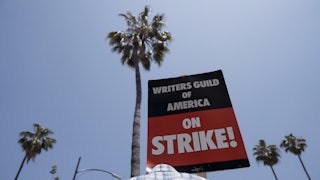Labor Day weekend marks a labor milestone in Los Angeles: The Writers Guild of America strike is now entering its fifth month, with little sign of abating. If it goes for much longer, it might become the longest strike in WGA history. Meanwhile, WGA sister union SAG-AFTRA—which represents actors—is almost two months into a strike of its own.
Major work stoppages occur for myriad reasons, and these two are no exception. Their causes include the threat that studios will replace human labor with algorithmically generated content; the persistence of a historically tight labor market, which has strengthened labor’s hand nationwide and contributed to a modest uptick in work stoppages; and the stupidity and myopia of studio executives, who can’t seem to stop themselves from constantly behaving like cretins in public.
But one of the most important background conditions for these two strikes is the housing crisis. As labor historian Nelson Lichtenstein recently noted, dizzying housing costs in Southern California have fueled a wave of labor actions that spans industries, from film writers to teachers to hotel workers. Besides Los Angeles, the other major epicenter for the WGA and SAG-AFTRA strikes is New York, which is similarly reeling from the effects of crushing rent inflation.
Writers and actors in the film and television industry have the advantage of organization: They can collectively withhold their labor until studio bosses agree to pay them enough to live in New York and Los Angeles. But artists, like American workers overall, are mostly not unionized. They either practice their craft at a net loss or on the thinnest of margins. The housing crisis has devastated that margin.
In the case of Nic Dyer, a painter who got their start in Baltimore, it has meant the difference between integrating into the New York art world and lingering on the outskirts. Dyer, who uses they/them pronouns, lives more than two miles upstate from the city in Hillsdale, a small town near Hudson. Their rent is $900 per month—a stretch, but far more doable than what they would be paying in Manhattan or Brooklyn.
The trade-off is that they’re far removed from any sort of cohesive artistic community. And that has impacted both their art and their earnings.
“I think I would really like the community, the environment [of New York],” Dyer told me. “And I think a lot of art is knowing people. People like to pretend it’s not, but that’s part of it.”
It’s not just Dyer and others like them who lose out. The American arts, as a number of commentators have observed, appear to be going through a period of stagnation. “My premise is that something is wrong,” the writer John Ganz wrote last September. “There’s something very slight and unsatisfying about recent film, television, art, architecture, design, fashion, cuisine—you name it. There are refreshing exceptions, of course, but they seem to quickly get counterfeited or compromised.”
My own premise is that this sense of wrongness is at least in part a direct consequence of the housing crisis. When high rents smother nascent art scenes, they also stymie the process through which American popular culture refreshes itself. It’s just another way in which the housing crisis has made us all poorer.
In the late 1960s and 1970s, New York was afflicted by any number of social and economic ills—crime, bankruptcy, addiction, poverty—but a housing shortage wasn’t one of them. Young artists could move to the city with virtually no possessions to their name and claw their way into any number of relatively low-cost housing options.
This is the story that poet and proto–punk rocker Patti Smith tells in Just Kids, her memoir about her friendship with the photographer Robert Mapplethorpe. One memorable chapter describes renting a room in the Hotel Chelsea, a fixture of the west side of lower Manhattan, and notes that rent was $55 per month. Even adjusted to 2023 dollars, that’s cheap.
This also happened to be one of the most creatively fecund periods in the city’s history. The scene surrounding punk club CBGB was an artistic explosion unto itself, giving us the Talking Heads, The Ramones, Blondie, and Television. Meanwhile, in the same year that CBGB opened its doors, the Bronx was giving birth to hip-hop.
If New York rents back then had been three or four times higher, we probably would have received only a fraction of that extraordinary musical bounty. In fact, we don’t need counterfactuals to see how higher rents would have killed the city’s alternative music scene: Just look at what happened after the New York indie rock boom of the late 1990s and early 2000s. That was the period when The Strokes, the Yeah Yeah Yeahs, TV on the Radio, and LCD Soundsystem first emerged. (Granted, The Strokes were prep school kids.) But by the mid-2000s, the New York scene was losing its preeminence as rising housing costs locked out young musicians.
Philadelphia was a beneficiary of sorts. Many of the leading next-generation indie acts—Japanese Breakfast, Lucy Dacus, Kurt Vile, and the War on Drugs, to name a few—are either from Philly or have since moved there, leading the Financial Times to say it “has quietly been one of American music’s most productive cities over the past decade or so.”
Noise-rock musician Mike Polizze moved to Philadelphia in 2004 from the suburb of Media, Pennsylvania, and shared concert lineups with Kurt Vile. “You could split a house between three or four people and be paying $400 a month,” he said of those days. But Philly, while still substantially cheaper than New York, has gotten pricier—so much so that Polizze now lives back in his hometown.
The housing crisis has an obvious solution: We need to build more homes, especially multifamily buildings in desirable metropolitan areas. New York is expensive because there aren’t enough apartments to go around; a city like Houston—which, incidentally, has a thriving local art scene—is cheaper because it has been building a lot more homes per capita, even as its population has grown significantly.
But that isn’t necessarily a palatable solution for artists who feel attached to a particular version of the city where they got their start. In our conversations, Dyer and Polizze both expressed ambivalence about new development. Whenever new apartment buildings went up in artsy neighborhoods, in their experience, the new units tended to be too expensive for the longtime residents.
“When they put in new buildings, they would even call them ‘artist’s lofts,’” Dyer said of their old neighborhood in Baltimore. “But they weren’t. They were expensive.”
There’s an answer to all of this, albeit an intuitively unsatisfying one. A large body of research shows that new market-rate units don’t raise neighborhood prices; quite the opposite. But in places with scarce housing, the market rate is naturally going to be very high. Baltimore will need a lot more shiny “artist’s lofts” before the rent on those units drops to a level that Dyer would consider affordable.
In the meantime, new development irrevocably transforms the look and feel of neighborhoods. Old buildings get replaced with new ones, and new people move in. No wonder, then, that Polizze spoke wistfully of the old Philly—and in particular Fishtown, the neighborhood that served as the center of his scene. “Philly just had character,” he said.
People who preferred the old Philly are justified in feeling they’ve lost something. But compare the city to places where fealty to “character” has defeated most efforts to build housing for new residents. San Francisco has paid dearly for its commitment to preserving its midcentury housing landscape. The invoice has come in the form of a hollowed-out middle class and homelessness on a staggering scale.
Cities change, and with change comes loss. But where cities reconcile themselves to change by accommodating new residents alongside old ones, they create opportunities for renewal. The New York indie rock scene circa the turn of the millennium isn’t coming back; but if the city reins in its housing crisis, think of the new artistic movements that America’s largest city could incubate. Think of what those movements could give to the rest of the country, and to the world.






